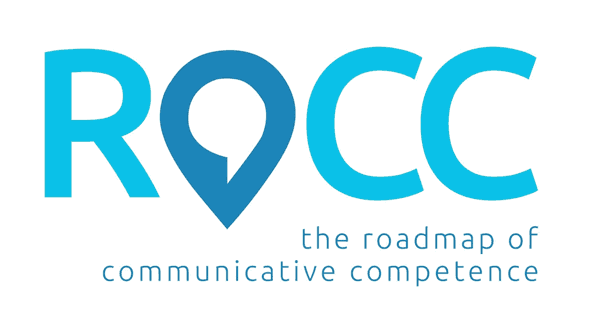This featured domain discussion is around Domain #10, BEING STRATEGIC – USING THE BEST OPTIONS FOR COMMUNICATION IN ALL SITUATIONS.
The goal: To select and use the most efficient and effective method of communication in any given situation.
As the final of the 10 domains incorporated into the profile scoring of ROCC, this one brings together many components of communication, and like Domain #9, it is not possible to include all aspects of this domain in the descriptors. However, the levels within Domain #10 aim to cover the development of strategies that ensure efficient and effective communication across settings, partners and types of messages. It’s this domain that will prompt us to consider the importance of multimodal communication, adjunct systems and many other clever strategies that enhance our interactions.
Why is this domain important?
Communication is an art not a science. It twists and turns depending on those involved in the interaction, the situation, environment, topic, how we feel, what just happened, and many other contributing factors.
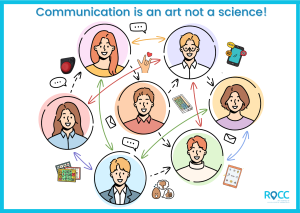
There is no recipe. Of course we need to learn the key structures like those listed in the other domains of ROCC but in Domain #10, we concentrate on how someone brings those together to create the masterpiece. Communication is a Two Way Street, and successful exchanges are dependent on each of those parties involved in the interaction. As an individual develops and becomes more experienced with interaction, they can learn strategic competencies that enable them to interact with more partners, skilled and unskilled, familiar and unfamiliar without scaffolding provided by others.
Consider baking a cake. Most of us can follow directions with basic ingredients to make something that resembles a cake and will be accepted by our loved ones or someone seeking a sugar fix, but a true baker knows how to adjust the technique and flavours to make something that is truly delicious and beautiful.
Strategic competence develops as we bake more interaction cakes. We figure out how to judge the situation, choose the most efficient mode/s, select words to convey our message and decide how it’s communicated in order to ensure a successful exchange. We learn what to do if our partner doesn’t hear or understand us, interprets our message incorrectly, or if we don’t know how to say the message we are trying to communicate. We also learn how to modify an interaction based on the way our partner responds or shares a message with us. We may need to ask them to clarify their message, or add more information, to ensure that we understand them. Strategic competence means learning to be more efficient and effective as both the sender and the receiver of a message.
Strategic competence also means starting with the right ingredients and tools to prevent breakdowns in the first place. This might include considerations for system selection and design, support and learning strategies, or communication partner training. Ultimately as an individual moves from emergent to more complex messages, they will learn to take responsibility for their own conversational efficiency, effectiveness and repair, but only if we model and allow them to experience this across time and from the early stages. For example, habits to ‘clear message’ prior to creating a new one on a speech generating device can begin early, even at the emergent levels when communication partners are providing aided language input and modelling the process. Success breeds success, so without strategies or scaffolding by a familiar partner to repair communication breakdown, an individual’s experience of interaction may be less successful and therefore less motivating.

Though strategic competence may seem like one of the later developing communication skills compared to other domains, we shouldn’t ignore it in the early stages. By doing this, strategic competence becomes an integrated component of communication development and can impact on early decisions around system design, support and learning strategies.
Scoring notes
In this domain, it’s important that we aim to score an individual at the level that best represents their current level rather than trying to find exact and specific examples within the descriptors. This domain includes a wide range of habits, strategies and tools, so scores should act only as a guide for those tasked with facilitating communication development. Getting to know an individual and their individual preferences, partners, settings and authentic interaction habits will give us the most information about what they may need to learn or what we can do to enable meaningful interactions.
The end goal
Light & Beukelmann (2020) describe strategic competence as the compensatory strategies that may be used to overcome environmental barriers or limitations in linguistic, operational and/or social skills. These strategies are relevant to all communicators regardless of mode, and are constantly changing as we interact with different people in different situations, for different purposes and at different times. As we mature and our communication becomes more refined, we learn strategies that work for us individually and how to anticipate and mitigate them for more efficient and effective communication with the people, settings and situations of our choosing (and even sometimes during those that are not of our choosing).
What can I do?
As with domain #9, the strategies to enable individuals to develop strategic competence are diverse and individual. The most successful approach is to scaffold learning through experience and practice within real situations. For those of us who are invested in providing individuals opportunities to develop and expand their communicative competence, it’s important to consider that helping is not always helping. Our focus should not be on solving communication challenges and breakdowns for the individual, but rather to enable them to learn to solve their own. At first for emergent communicators this could involve communication partner training, specific instructions, design elements within their communication system and modelling strategic competencies within real and genuine interactions.
Later, after they have had opportunities to learn, we can provide time and scaffolding for them to begin to do this for themselves.
Transitional communicators may need words or phrases to say things like “I don’t know” or “ask someone” as well as suggestions from their communication partner to “tell me more” or if needed, model more than one possible interpretation of their message and seek clarification. For example, “You said “motorbikes” maybe you are telling me you like them, you saw one, you want to talk about them, or something else. As you do this, you may model the key words (such as those underlined) in their mode of communication, or if they are ready, just indicate the pathways where they might find additional vocabulary without prompting the exact word/s.
Also at this level, individuals may need to learn that even when you express your message clearly, the circumstances may be such that you are not heard or understood. For example, a communication partner may not know the person they are talking about, or may not hear or see their message the first time. In these instances, coaching the person rather than just fixing the message can help them to experience success and learn new strategies.
At other times, experiencing breakdown or working together to figure out a more complex message can provide opportunities to suggest and talk about the most efficient and effective method of communication. For example, you may coach an individual to “call out before you point” or “you could tell me that with your signs/device”, or “it might be easier to say that if you go to the questions page first”.
Other examples of compensatory strategies might include helping the individual learn to say, sign or select phrases like “I didn’t hear you”, “it’s something we were just talking about”, or “put that word in my communication device”. Importantly, a person learns these strategies through practice and scaffolded success. The more opportunities an individual has to experience success and observe others using these strategies, the more likely they are to add them to their own toolkit.
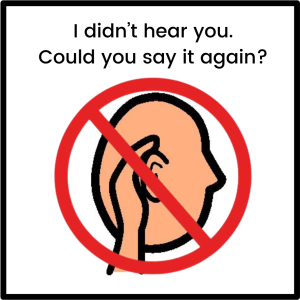
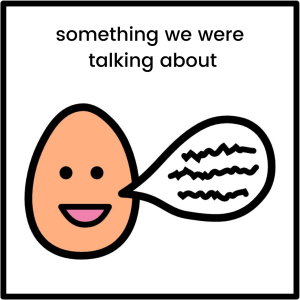
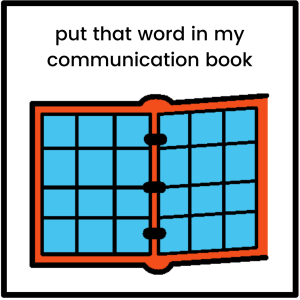
Those who use aided AAC systems may also require additional and very specific strategic competencies particularly in relation to time and layout of vocabulary. It may be of enormous benefit for both the individual and those facilitating their learning to watch and if possible interact with skilled users of theirs or a similar system. Videos and real interactions provide this opportunity to observe the art of aided communication and strategic competencies as they arise in genuine interactions.
Useful links on this topic:
Videos of AAC users available to share with others.
Presentations by AAC users (just a starter list):
You can also learn more about Domain 10 in the context of ROCC by doing the ROCC Basic Training.
To find out more about Domain 10 or any other Domain, get in touch with us at rocc@roccassessment.com.au
References
Beukelman, D. R., & Light, J. C. (2020). Augmentative & alternative communication: Supporting children and adults with complex communication needs (Fifth edition). Paul H. Brookes Publishing Co., Inc.
Light, J. (1989). Toward a definition of communicative competence for individuals using augmentative and alternative communication systems. Augmentative and Alternative Communication, 5(2), 137–144. https://doi.org/10.1080/07434618912331275126
